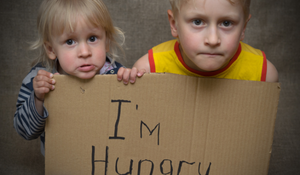 We recently overheard two nine-year-olds discussing a Thanksgiving food bank ad they happened to be watching on T.V.
We recently overheard two nine-year-olds discussing a Thanksgiving food bank ad they happened to be watching on T.V.
NYO#1 “Look at all those turkeys. Who gets them all?"
NYO#2 "Hungry children in China."
NYO#1 "Do they have Thanksgiving in China?"
NYO#2 "I guess so. They must, or they wouldn't need so many turkeys."
NYO#1 "Wow. They sure have a lot of hungry people."
NYO#2 "Yup. They do. Everybody in China is hungry."
Studies show that most American adults share the innocence of these two children and have no idea how many American families go hungry every day. The U. S. Department of Agriculture reports annually on the extent of what they euphemistically refer to as "food insecurity" in America. As a gentle reminder, here is the essence of their report for 2021. The numbers are shocking.
Staggering Numbers
In its report, Household Food Security in the United States 2021, the USDA reports that 13.5 million U.S. households were food insecure at some time during 2021! Food insecure households are defined as households who were uncertain of having or unable to acquire enough food to meet the needs of all their members because they had insufficient money or other resources. The USDA report divides "food insecurity" into two categories:
- Low food security—8.4 million U.S. households had low food security in 2021. These food-insecure households obtained enough food to avoid substantially disrupting their eating patterns or reducing food intake by using a variety of coping strategies, such as eating less varied diets, participating in Federal food assistance programs, or getting food from community food pantries.
- Very low food security—5.1 million U.S. households had very low food security at some time during 2021. In these food-insecure households, normal eating patterns of one or more household members were disrupted and food intake was reduced at times during the year because they had insufficient money or other resources for food. In other words, they simply went hungry.
How Many People Lived in Food-insecure Households?
- 33.8 million people lived in food-insecure households in the U.S. in 2021.
- 8.6 million adults lived in households with very low food security (went hungry).
- 5.0 million children lived in food-insecure households in which children, along with adults, were food insecure.
- 521,000 children lived in households in which one or more children experienced very low food security (went hungry).
Who Are the Hungry?
The prevalence of very low food security in various types of households followed a pattern like that observed for food insecurity overall. Very low food security was more prevalent than the national average (3.8%) for the following groups:
- Overall, households with children had a substantially higher rate of food insecurity (12.5%) than those without children (9.4%).
- Households with children headed by a single woman (8%).
- Women living alone (6.0 percent) and men living alone (5.9%).
- Households with reference persons who are Black, non-Hispanic (7.9%) and Hispanic (5.5%).
- Households with incomes below 185% of the poverty line (10.2%).
Where Do They Live?
- The prevalence of food insecurity was highest for households located in principal cities of metropolitan areas (12.2%), near the national average in nonmetropolitan areas (10.8%), and lowest in suburban and other metropolitan areas outside principal cities (8.8%).
- Regionally, the prevalence of food insecurity in the Northeast (8.8%) was significantly below the U.S. average, while the prevalence in the South (11.4%) was significantly above the U.S. average.
How Can We Help?
Science tells us that about 40% of food produced, processed, and transported in the U.S. is wasted and ends up in our landfills. Nationally we spend hundreds of billions of dollars growing, processing, and disposing of food that is never eaten. Nonprofits like Rescuing Leftover Cuisine and many others close the gap between wasted food and food insecurity by redistributing food that already exists. Diverting just 15% of currently wasted food would bring the number of food insecure Americans down by 50%. Contact a food bank or a food redistribution nonprofit in your area to see how you might help by volunteering or donating.

